Physical Address
304 North Cardinal St.
Dorchester Center, MA 02124
Physical Address
304 North Cardinal St.
Dorchester Center, MA 02124
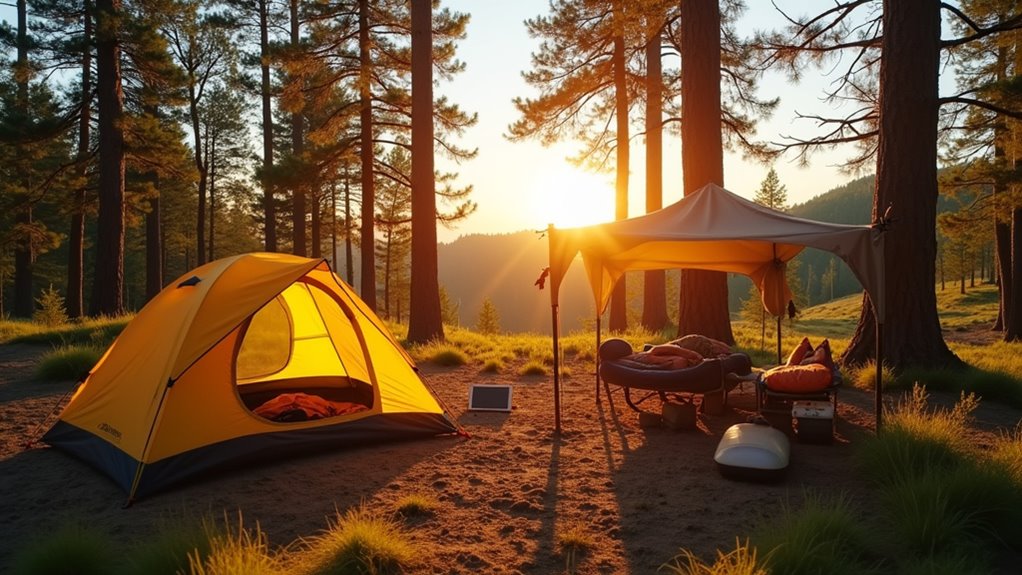
Cool down your sweltering summer tent with these 9 genius hacks that will transform your camping experience into comfortable nights under the stars.
You’ve planned the perfect summer camping trip, but there’s one challenge that can turn your outdoor adventure into a sweaty nightmare: sleeping in a hot tent. While you can’t control Mother Nature’s thermostat, you can outsmart the heat without breaking the bank. Smart campsite selection, clever ventilation tricks, and a few budget-friendly cooling hacks will transform your sweltering shelter into a comfortable retreat. Here’s how to beat the heat and actually enjoy your summer nights under the stars.
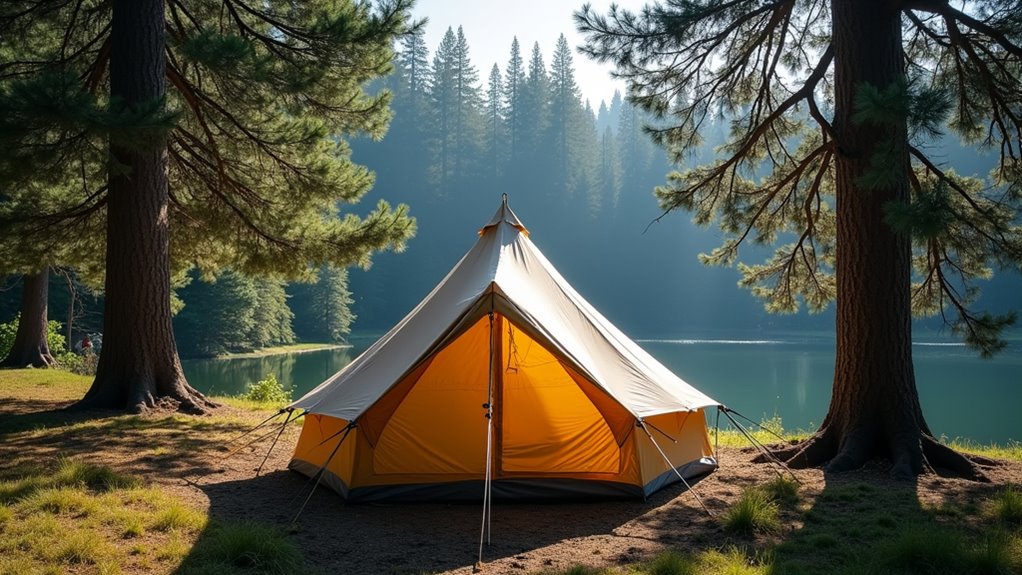
When you’re scouting for the perfect spot to pitch your tent, look for natural shade from trees or rock formations that’ll block the sun’s harshest rays throughout the day.
Position your tent’s entrance facing east so cool morning breezes can flow through while avoiding the afternoon sun that beats down from the west.
Elevated spots catch more wind, which helps with ventilation, but avoid exposed ridges where you’ll get pummeled by direct sunlight.
Creek beds and valleys stay cooler but can trap hot air, so find that sweet spot on a gentle slope with tree cover.
Check overhead for dead branches that could fall, and remember that morning shade doesn’t guarantee afternoon relief.
Once you’ve set up camp in your ideal cool spot, you’ll have the perfect base for enjoying family camping activities that everyone can participate in during the more comfortable parts of the day.
Once you’ve found your ideal campsite, the way you position and configure your tent can make the difference between a sweltering night and comfortable sleep. Face your tent’s entrance toward prevailing winds to maximize airflow through the interior. Don’t orient it east-west, as morning sun will turn your tent into an oven by dawn.
Keep your tent elevated slightly by choosing ground that’s naturally raised or using a basic tarp underneath for air circulation. If your tent has a rainfly, you’ll want to create maximum space between it and the inner tent – this gap acts as insulation.
Open all vents and mesh panels before the temperature peaks. Position guy-lines to create tension that maximizes interior space, allowing hot air to rise and escape more effectively. Remember that your camping clothes choices also impact heat retention, so select lightweight, breathable fabrics that won’t trap additional warmth inside your tent.
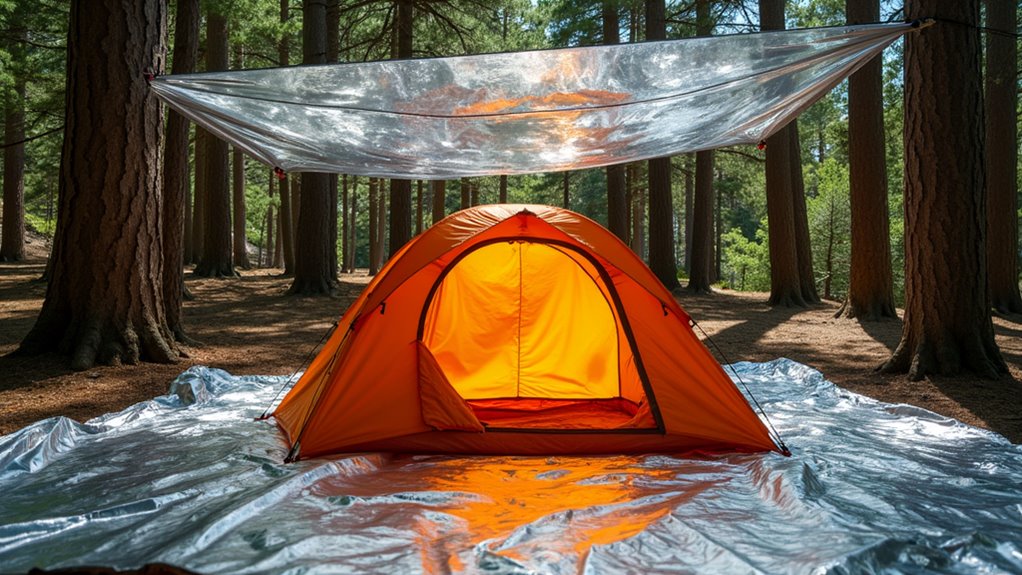
While strategic tent placement helps, adding reflective materials creates an extra barrier against heat absorption. You don’t need expensive gear—basic reflective tarps and emergency blankets work perfectly for deflecting sun rays away from your tent.
These budget-friendly solutions markedly reduce interior temperatures:
Simple reflective materials like emergency blankets and tarps can dramatically lower your tent’s internal temperature without breaking the budget.
For jungle environments where humidity and heat create particularly challenging conditions, consider upgrading to a jungle camping hammock setup with reflective covers for maximum cooling efficiency.
Though reflective materials block external heat, proper airflow remains your most powerful weapon against stuffy tent conditions. Open all available vents, windows, and mesh panels to create cross-ventilation. Position your tent’s door and back vents to catch prevailing breezes. Don’t zip everything shut during the day – hot air needs escape routes.
Create additional airflow by propping up your rainfly with trekking poles or guy-lines, leaving gaps between the fly and tent body. This chimney effect pulls hot air up and out.
Face your tent opening toward expected wind direction when setting up camp.
For budget-friendly ventilation boosts, bring battery-powered fans or hang wet bandanas near vents. The evaporation creates natural cooling while fans circulate air effectively throughout your sleeping space.
When cycling worldwide, these ventilation techniques become even more critical since you’ll likely encounter diverse climate conditions and need reliable cooling methods that work with your mobile camping setup.
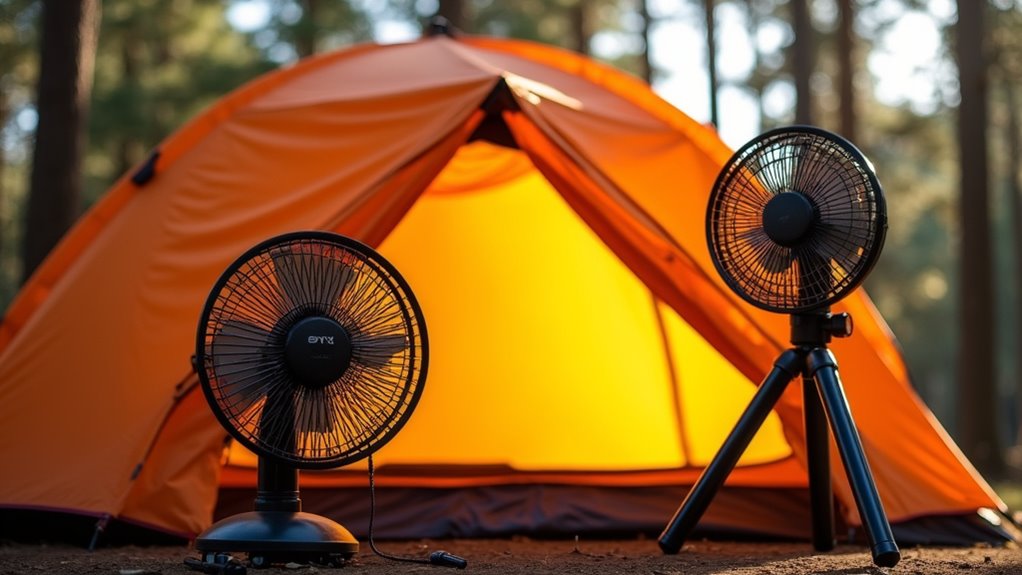
Battery-powered fans transform your tent from a sweltering sauna into a livable shelter, and you don’t need to break the bank to stay cool. These portable cooling companions run on rechargeable batteries or standard AAs, making them perfect for off-grid adventures.
Position your fan strategically to create cross-ventilation with your tent’s existing vents. You’ll feel the difference immediately as stagnant air starts moving.
Budget-friendly options that’ll keep you comfortable:
Choose fans with variable speeds to conserve battery life during cooler evening hours. For even better ventilation and cooling options, consider upgrading to caravan camping where you’ll have more space and power options for larger fans and air conditioning units.
Since your tent acts like a greenhouse when exposed to direct sunlight, building shade structures around your campsite becomes one of the most effective ways to drop temperatures by 10-15 degrees.
You don’t need expensive gear to create effective shade. String a tarp between trees or use trekking poles as anchors. Position the shade cloth above and slightly away from your tent, allowing air to circulate underneath. This creates a double-layer cooling effect.
Position your shade cloth above and slightly away from your tent to create a double-layer cooling effect with proper airflow.
For budget-friendly options, try emergency blankets or old bedsheets. Even a large beach umbrella works well for smaller tents. The key is blocking direct sun exposure while maintaining airflow.
Set up your shade structure on the side where morning sun hits hardest, typically the eastern exposure. After creating your cooling setup, consider how you’ll maintain personal hygiene during hot weather by exploring camping shower options that work well in outdoor environments.
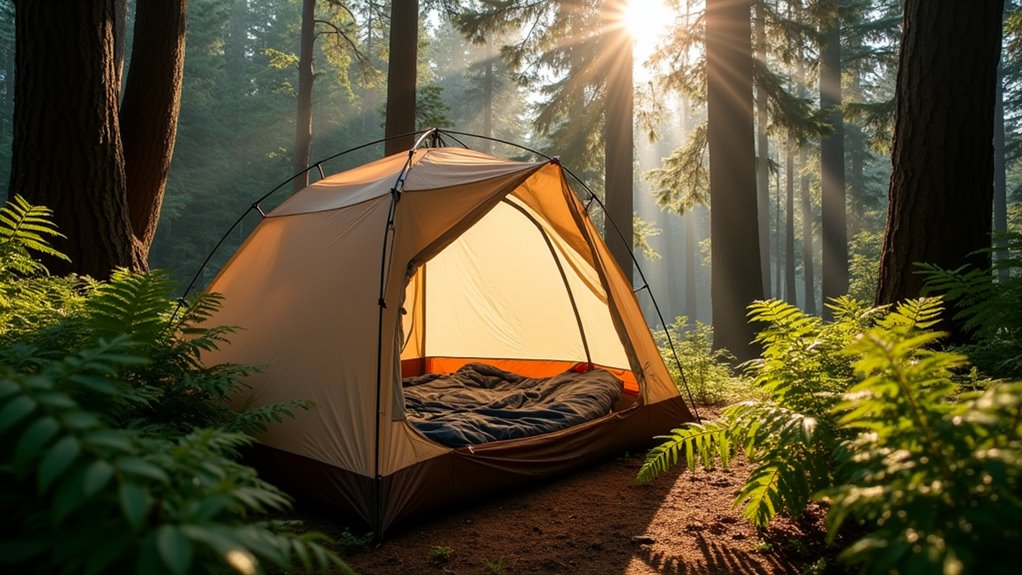
While shade structures help during the day, smart timing can make your nights much more comfortable. You don’t need expensive gear—just adjust when you sleep and wake up to work with nature’s temperature cycles.
Here’s how to time your rest around heat patterns:
This schedule lets you avoid the brutal 2-6 PM heat while maximizing comfortable sleeping time. You’ll sleep better and wake up refreshed instead of sweaty. While summer camping focuses on beating the heat, winter campers face the opposite challenge of staying dry in cold, wet conditions that can make tents uncomfortable.
Your tent’s fabric and gear choices make the difference between sleeping in a sauna and staying reasonably cool through hot nights. Look for tents with mesh panels that maximize airflow – these create cross-ventilation that pushes hot air out.
Cotton-poly blends breathe better than pure synthetic materials, though they’re slightly heavier.
Skip the expensive “cooling” fabrics and focus on ventilation features instead. Double-wall tents with full rainflies trap heat, so consider single-wall options for dry climates.
Your sleeping bag matters too – synthetic fills retain less heat than down. A simple cotton sheet or lightweight sleeping bag liner works great in hot weather.
Don’t forget mesh storage pockets and gear lofts that keep items off the tent floor, allowing air to circulate underneath your belongings.
Remember that proper gear selection is just one part of creating a memorable camping experience that you’ll want to repeat season after season.
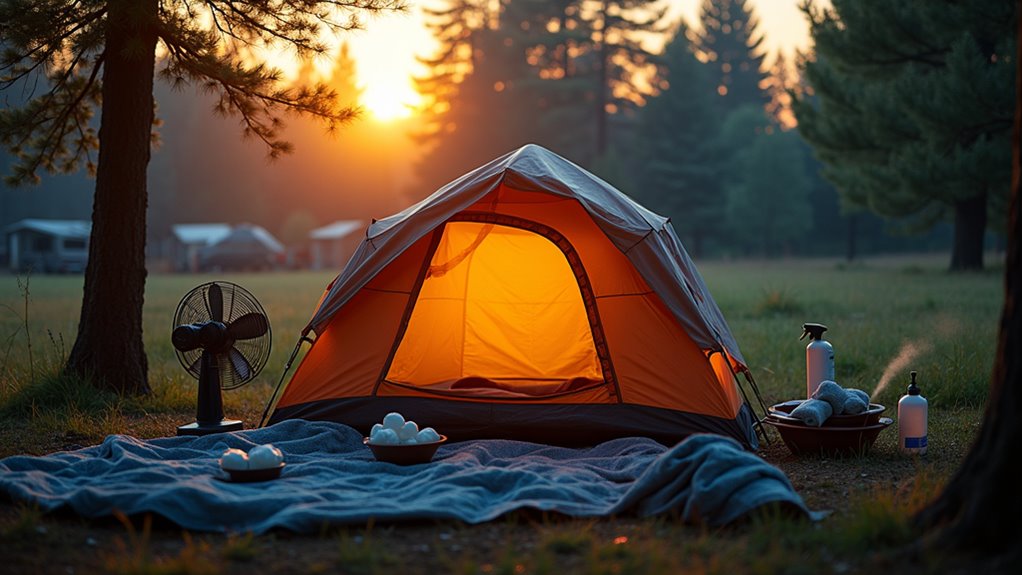
Before you zip up for the night, take fifteen minutes to actively cool your tent and body temperature. These simple pre-bedtime rituals make the difference between tossing all night and getting quality sleep.
Don’t skip this cooling routine – it’s your best defense against midnight heat waves that’ll wake you up sweating. Whether you’re camping in desert valleys or exploring the Andes mountains, these cooling techniques will help you sleep comfortably even in challenging temperatures.
You’ll transform your tent from a blazing oven into a cool oasis with these game-changing strategies. Don’t let summer heat turn your camping adventure into a sweaty nightmare—you’ve got the power to beat Mother Nature at her own game! These budget-friendly tricks will have you sleeping like a baby while other campers toss and turn in their furnace-like shelters. Your future self will thank you when you’re snoozing comfortably under the stars.